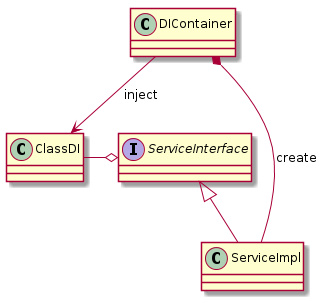Pipeとは
- Template構文の中で用いる、データ変換を行う仕組み
- Linux の パイプ処理 に概念的には近い
-
ps | grep nodeみたいなやつ
-
Pipeの利用例
- i18n対応用にカスタムの言語辞書変換をPipeを使って実現する
<div>{{ 'HELLO' | translate }}</div>
組み込みのPipe
- AsyncPipe
- CurrencyPipe
- UpperCasePipe/LowerCasePipe
他、以下のようなものがある。
https://angular.io/api/common#pipes
自作のPipe
@Pipe デコレータを利用したクラスを作成することで実現する。また、Componentと同様にapp.module.tsのdeclerarions に追加が必要
import { Pipe, PipeTransform } from '@angular/core';
@Pipe({name: 'exponentialStrength'})
export class ExponentialStrengthPipe implements PipeTransform {
transform(value: number, exponent?: number): number {
return Math.pow(value, isNaN(exponent) ? 1 : exponent);
}
}
これまでのおさらい / Angularのポイント
- 依存関係や定義を明確に定義することで、パーツごとの管理をやりやすくする
module機構 - UIをページごと、部品ごとに分割し、再利用しやすくする
component機構 - UIとコードとのデータのやり取りを実現する
binding機構 - 異なるUI部品に対して共通的な処理を追加できる
directive機構 - 文字列や数値などのデータの変換処理を簡便に記述できる
pipe機構
最後は設計の話 / 依存性注入(Dependency Injection)について
DIとは何か(再掲)
DIとはもともとはJavaなどのサーバーサイドの分野でよく用いられてきた、疎結合を保ったまま依存関係を構築する手法である。
DIを実現する仕組みをDIコンテナといい、Angularにもその仕組は組み込まれている。主な挙動としては以下のようになる。
- サービスを利用するクラス側が、どのサービスが必要かを記述する。
- DIコンテナにサービスを登録する
- DIコンテナが起動時に依存性を解決し、生成したサービスをクラスに注入する
なんでそんなややこしいことするんですか?
DIのポイント
- 実クラスではなく、抽象クラス/インタフェースを参照することで、クラス間を疎結合に保つ
- 変更の影響範囲の限定
- テスタビリティの向上(モックの導入)
- 依存性を逆転させることで、モジュールの可搬性を上げる



